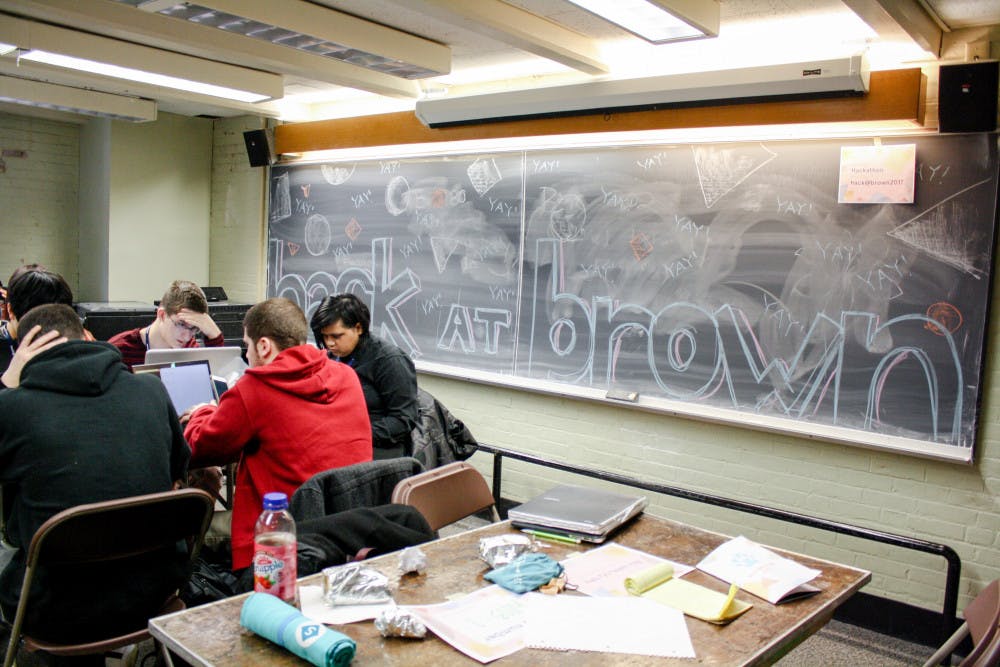Over 500 students and professionals from around the world gathered this past weekend to participate in the University’s annual Hack@Brown, 24 hours packed full of learning, creating and building. Hackers were provided access to some of the top tools and mentors to help design and present their own software projects.
Hosted by the student-run organization Hack@Brown, the hackathon was preceded by “Hack Week,” in which Hack@Brown students ran a series of workshops to learn about different topics in technology and design. These events were open to all Brown and Rhode Island School of Design students, regardless of prior coding experience, giving them the opportunity to learn a new skill or pick up knowledge to be applied towards hackathon projects, said Max Luzuriaga ’18, co-leader of Hack@Brown.
This year’s Hack Week and hackathon prioritized inclusion of thosewith little coding experience, said Katie Hsia ’17, co-leader of Hack@Brown.
“I’ve never even been to a hackathon before, but I just tweeted from a Chrome extension I just learned to make myself,” said Stephanie Alvarado ’20 after the “Intro to Chrome Extensions” workshop. The workshops were accessible entry points for students not concentrating in computer science, a field that can come across as intimidating, said Ankita Sharma ’19, who ran the Chrome extension workshop.
“I’m new to coding and wanted to come to Brown’s hackathon because I heard it was really good for beginners,” said Mir Lim, a senior at Boston University. “It’s been a really collaborative atmosphere.”
This year’s Hack@Brown also broke the “coders only” stereotype of hackathons by emphasizing design, product management and user experience more than previous years, Hsia said. Some of the less coder-centric workshops — such as “Learn how to use Sketch” — were taught by RISD students and focused on design.
The hackathon was open to high school and college students who, in addition to learning new technology skills, came to meet new people, explore Brown’s campus and apply skills learned at previous hackathons.
Hack@Brown has earned a reputation around the world. Martha Czernuszenko, a business major at University of Texas at Austin, applied to join the hackathon after first hearing of it while in London.
Mentors from the professional world also travelled to College Hill to take part in the hackathon and recruit students.
Marcin Romaszewicz ’98, a CS concentrator, returned for the hackathon to find new interns and future graduates for his San Francisco-based company, which was co-founded with another Brown alum, he said. “It’s also fun to see what kind of technologies students are using these days to get their foot in the door, because this sort of thing wasn’t possible when I graduated,” he added.
A group of RISD and Brown students won the award for best first-time hackers for their creation of a wearable device for those with visual impairments that senses its surroundings and notifies the user about any nearby obstruction or elevation changes.
“We were all interested in hardware, so our team of entirely new people just decided to join”, said Jillian Cai, a RISD student on the team. She added that one of the best parts of participating in the hackathon was meeting other students from Brown.
The Social Impact Winners team consisted of sophomores from Brown who participated in the hackathon for the first time last year. In returning, they hoped to use what they had learned last year to make a new product, said Lauren Ho ’19, a member of the team. Together, they created a two-fold Chrome Extension and website that presents a news story from both the liberal and conservative perspective side by side.
“The atmosphere of hackathon makes it easy to create something in just 24 hours,” said Lucy Wei ’19, a Herald web editor who led the “Launching your own Online Portfolio” workshop. “It shows that the only thing stopping me … is my own motivation.”





